If you come from the world of films, you may remember using filters to correct for incandescent or fluorescent lighting. Most people don't bother and their indoors pictures invariably come out with a yellow/orange or bluish cast. In the digital world, these correction filters are no longer necessary, replaced by a feature found in most -- even the entry-level -- digital cameras called, "White Balance."
Light Colour Temperature
The reason that pictures turn out with a yellow/orange cast in incandescent (tungsten) lighting and bluish in fluorescent lighting is because light has a colour temperature. A low colour temperature shifts light toward the red; a high colour temperature shifts light toward the blue. Different light sources emit light at different colour temperatures, and thus the colour cast.
By using an orange or blue filter, we absorb the orange and blue light to correct for the "imbalance" -- the net effect is a shift in the colour temperature.
In digital photography, we can simply tell the image sensor to do that colour shift for us. But how do we know in which direction of the colour temperature to shift, and by how much?
Manual White Balance
This is where the concept of "White Balance" comes in. If we can tell the camera which object in the room is white and supposed to come out white in the picture, the camera can calculate the difference between the current colour temperature of that object and the correct colour temperature of a white object. And then shift all colours by that difference.
Most advanced digital cameras therefore provide the feature to manually set the white balance.
By pointing the camera at a white or gray card (angled so that it is reflecting light from the room) as a neutral reference, filling the screen completely with it, then pressing the White Balance button (or set it in the menu), the camera does its WB calculation.
From then on, any picture taken will have its colour temperature shifted appropriately. It's quite simple, really, and you should not be afraid to try it out and see your indoors pictures improve considerably (assuming there is enough light for correct exposure).
[A "neutral" gray is 18% gray and will reflect all colors equally.]
Caution:
- Ensure the card is not in shadows, but illuminated by the artificial light in the room
- If you are bouncing light off the walls, ensure the card is reflecting the bounced light
- Beware of mixing artificial lights -- in this case, you might want to use RAW and adjust in post processing for each light
- Beware of fluorescent light: since fluorescent light does not contain all the spectrum of light, you may obtain unexpected results
Preset White Balance
To help us in those special situations without having to go through the trouble of manually setting the white balance everytime, cameras provide preset WB settings such as, Tungsten, Fluorescent, Cloudy, Sunny, etc. Using preset WB can improve on a picture, especially under indoors lighting.
In the above example, the picture on the left is taken with the camera set to Auto WB. The indoor lighting is by two ordinary incandescent (tungsten) bulbs from the ceiling. It's not bad, but the fan should really be white. By dialing in a preset Tungsten WB, the image gives a truer representation of the scene.
Usually just selecting a Preset WB setting appropriate for the lighting situation is enough.
Auto White Balance
Since the days of the Kodak Brownie cameras, manufacturers have tried to automate everything for us. Hence, today's digital cameras also all sport an Auto White Balance (AWB) function. Depending on the camera brand, some AWB works better than others. On the whole, though, AWB works very well in sunny and cloudy outdoors, and fine for most indoors situations (a little orange or bluish cast does sometimes contribute to the mood of the picture anyway, e.g. the warm orangle glow of a candle).
Set your digital camera to AWB and take pictures under tungsten, fluorescent, and mixed lighting (i.e. tungsten or fluorescent, plus natural light coming through the window), and see if the results are OK. If they are, you can just use AWB.
Snow
Pictures of snow scenes typically reproduce the snow not as white but with a bluish tinge. Sometimes, the blue adds to the mood of the picture, but at other times you may want to remove the blue.
If your digital camera allows custom WB, then set the White to the snow and the blue should disappear.
If your digital camera does not allow custom WB, then post processing can be as effective. In Photoshop Elements, I used Enhance - Color - Color Cast... to specify the snow as being white, and the resulting image is as good as the one using custom WB.
Special Effects
Once you've selected a WB setting, just remember to reset this white balance setting when you head back outdoors into natural light, or you may end up with some strange, out of this world, colours.
In fact, by dialing in a WB setting inappropriate for the lighting situation allows us to create some special effects.
Let's say you are taking a picture outdoors and you want to make the light warmer, perhaps creating a late evening, sunset effect. To do that, we dial in a Fluorescent WB, in effect telling the camera that the light is too cool. The camera responds by shifting every colour toward the warm, red values. Dial in a Tungsten WB, and the camera shifts all colours toward the cool, blue values. Lots of trial and error recommended here.
RAW File Format
A discussion in WB would not be complete without a mention of the RAW file format available in many advanced digital cameras. When you save an image in RAW file format, you are saving it the way the image sensor sees it -- without applying any adjustments (including white balance) to it. In fact, the camera ignores any WB setting you dial in.
Later, in an image editing software with the appropriate RAW plug-in, you can convert the RAW image to JPEG, and apply any colour temperature shift. Undo your change and try again, ad infinitum, in as fine an increment as you wish, until you obtain perfect colour balance.
Some professional photographers always use RAW file format. Saving in RAW file format comes at a price because it takes so much longer to save a RAW image that it might not be practical in many picture taking situations. Professional dSLRs (and some prosumer models) have internal buffers that allow RAW images to be taken one after the other in quite rapid succession without having to wait for the saving of one image to be completed before you can take the next picture.
If you are taking landscapes, and it's early in the morning or late in the evening, or you are not too sure of which WB setting to use, try it in RAW.
A few digital cameras even allow you to save an image in both RAW and JPEG simultaneously, though time to write to memory card is proportionally increased.
Summary
For most of us, Auto WB is fine and does a pretty good job in diverse situations, outdoors and indoors.
For those occasions when you are not happy with the colour cast of your picture, choose one of the preset WB settings.
If this still does not give you what you want, consider manually setting the white balance by using a white card or sheet of paper (or white T-Shirt, etc.).
And, for ultimate control over white balance, consider shooting in RAW file format, and adjust in post-processing.
Light Colour Temperature
The reason that pictures turn out with a yellow/orange cast in incandescent (tungsten) lighting and bluish in fluorescent lighting is because light has a colour temperature. A low colour temperature shifts light toward the red; a high colour temperature shifts light toward the blue. Different light sources emit light at different colour temperatures, and thus the colour cast.
By using an orange or blue filter, we absorb the orange and blue light to correct for the "imbalance" -- the net effect is a shift in the colour temperature.
In digital photography, we can simply tell the image sensor to do that colour shift for us. But how do we know in which direction of the colour temperature to shift, and by how much?
Manual White Balance
This is where the concept of "White Balance" comes in. If we can tell the camera which object in the room is white and supposed to come out white in the picture, the camera can calculate the difference between the current colour temperature of that object and the correct colour temperature of a white object. And then shift all colours by that difference.
Most advanced digital cameras therefore provide the feature to manually set the white balance.
By pointing the camera at a white or gray card (angled so that it is reflecting light from the room) as a neutral reference, filling the screen completely with it, then pressing the White Balance button (or set it in the menu), the camera does its WB calculation.
From then on, any picture taken will have its colour temperature shifted appropriately. It's quite simple, really, and you should not be afraid to try it out and see your indoors pictures improve considerably (assuming there is enough light for correct exposure).
[A "neutral" gray is 18% gray and will reflect all colors equally.]
Caution:
- Ensure the card is not in shadows, but illuminated by the artificial light in the room
- If you are bouncing light off the walls, ensure the card is reflecting the bounced light
- Beware of mixing artificial lights -- in this case, you might want to use RAW and adjust in post processing for each light
- Beware of fluorescent light: since fluorescent light does not contain all the spectrum of light, you may obtain unexpected results
Preset White Balance
To help us in those special situations without having to go through the trouble of manually setting the white balance everytime, cameras provide preset WB settings such as, Tungsten, Fluorescent, Cloudy, Sunny, etc. Using preset WB can improve on a picture, especially under indoors lighting.
| White Balance | |
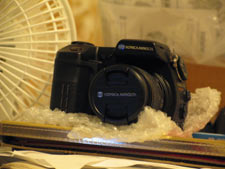 | 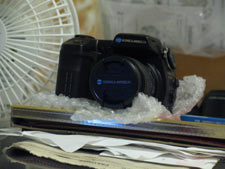 |
| AWB | Preset WB = Tungsten |
Usually just selecting a Preset WB setting appropriate for the lighting situation is enough.
Auto White Balance
Since the days of the Kodak Brownie cameras, manufacturers have tried to automate everything for us. Hence, today's digital cameras also all sport an Auto White Balance (AWB) function. Depending on the camera brand, some AWB works better than others. On the whole, though, AWB works very well in sunny and cloudy outdoors, and fine for most indoors situations (a little orange or bluish cast does sometimes contribute to the mood of the picture anyway, e.g. the warm orangle glow of a candle).
Set your digital camera to AWB and take pictures under tungsten, fluorescent, and mixed lighting (i.e. tungsten or fluorescent, plus natural light coming through the window), and see if the results are OK. If they are, you can just use AWB.
Snow
Pictures of snow scenes typically reproduce the snow not as white but with a bluish tinge. Sometimes, the blue adds to the mood of the picture, but at other times you may want to remove the blue.
If your digital camera allows custom WB, then set the White to the snow and the blue should disappear.
| Snow - Using Custom WB | |
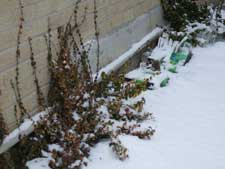 | 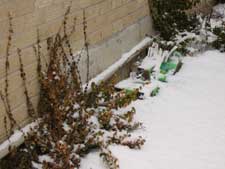 |
| AWB | Custom WB |
| Snow - Color Cast in Photoshop | |
 | 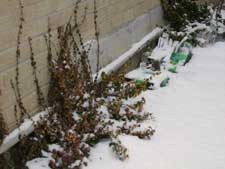 |
| AWB | Color Cast in Photoshop |
Once you've selected a WB setting, just remember to reset this white balance setting when you head back outdoors into natural light, or you may end up with some strange, out of this world, colours.
In fact, by dialing in a WB setting inappropriate for the lighting situation allows us to create some special effects.
Let's say you are taking a picture outdoors and you want to make the light warmer, perhaps creating a late evening, sunset effect. To do that, we dial in a Fluorescent WB, in effect telling the camera that the light is too cool. The camera responds by shifting every colour toward the warm, red values. Dial in a Tungsten WB, and the camera shifts all colours toward the cool, blue values. Lots of trial and error recommended here.
RAW File Format
A discussion in WB would not be complete without a mention of the RAW file format available in many advanced digital cameras. When you save an image in RAW file format, you are saving it the way the image sensor sees it -- without applying any adjustments (including white balance) to it. In fact, the camera ignores any WB setting you dial in.
Later, in an image editing software with the appropriate RAW plug-in, you can convert the RAW image to JPEG, and apply any colour temperature shift. Undo your change and try again, ad infinitum, in as fine an increment as you wish, until you obtain perfect colour balance.
Some professional photographers always use RAW file format. Saving in RAW file format comes at a price because it takes so much longer to save a RAW image that it might not be practical in many picture taking situations. Professional dSLRs (and some prosumer models) have internal buffers that allow RAW images to be taken one after the other in quite rapid succession without having to wait for the saving of one image to be completed before you can take the next picture.
If you are taking landscapes, and it's early in the morning or late in the evening, or you are not too sure of which WB setting to use, try it in RAW.
A few digital cameras even allow you to save an image in both RAW and JPEG simultaneously, though time to write to memory card is proportionally increased.
Summary
For most of us, Auto WB is fine and does a pretty good job in diverse situations, outdoors and indoors.
For those occasions when you are not happy with the colour cast of your picture, choose one of the preset WB settings.
If this still does not give you what you want, consider manually setting the white balance by using a white card or sheet of paper (or white T-Shirt, etc.).
And, for ultimate control over white balance, consider shooting in RAW file format, and adjust in post-processing.









0 comments:
Post a Comment